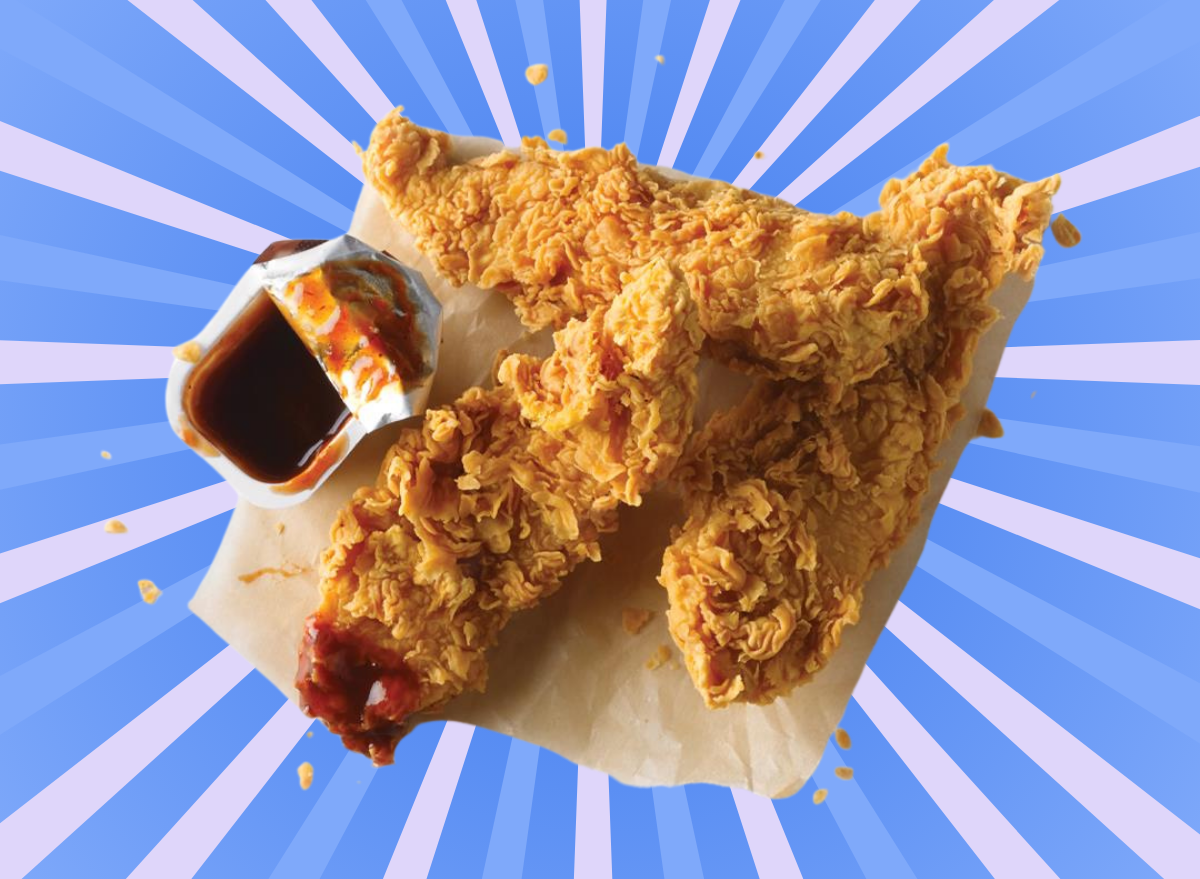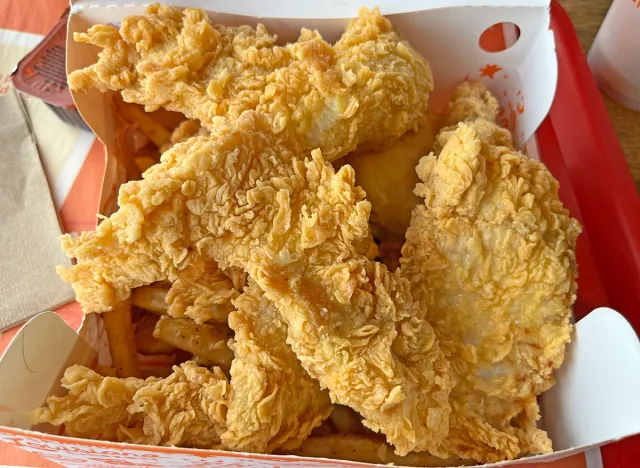Raising Cane's vs. Popeyes: Which Has the Best Chicken Tenders?

These days, fast-food chains sell fried chicken in many forms, from classic bone-in pieces to bite-sized boneless nuggets and everything in between.
One popular item appears on many menus under many different names. I'm referring, of course, to the long, narrow sections of white meat, often called strips, fingers, or tenders.
Now, a butcher or poultry purist will tell you there's a big difference between a tender and a finger or a strip. Technically speaking, a tender is a specific cut of the inner chicken breast, whereas a finger or a strip can be sliced from pretty much any part of the breast. But when it's all battered, deep-fried, and dipped in some delicious sauce of your choosing, who can really tell the difference?
The fast-growing chicken chain Raising Cane's specializes in this style of fried chicken, basing its entire business model on chicken fingers—which the company describes as its "one love." The only real question to answer when ordering is how many fingers you want in your basket and whether you want cole slaw with that. (Fries, dipping sauce, Texas toast, and a drink come standard with every meal.)
Yes, if you want a chicken sandwich, you can get one. Cane's simply slaps three of its signature chicken fingers on a bun—there's your sandwich!
It's a very specific niche, but it's clearly working for the burgeoning Louisiana-based company. Raising Cane's plans to open some 90 new U,S. restaurants in 2024 alone.
I wanted to see how Cane's laser-focused chicken fingers compared to those from one of the major, more multi-faceted chicken chains. Popeyes, for instance, initially made its mark with bone-in fried chicken before triggering a fast-food arms race with its hyper-popular chicken sandwich in 2019 and more recently expanding into hot wings. Like Cane's, Popeyes comes from Louisiana roots, and its chicken tenders outperformed four fast-food rivals in a 2023 Eat This, Not That! taste test.
I recently visited both chains and ordered a three-piece meal from each. Here's how these "strips" (for lack of a more common term) stacked up:
Popeyes

Tenders – Classic or Spicy (Per 3 Pieces)
Calories: 450
Fat: 21 g (Saturated Fat: 9 g, Trans Fat: 1 g)
Sodium: 1,820 mg
Carbs: 29 g (Fiber: 2 g, Sugar: 0 g)
Protein: 38 g
Popeyes chicken tenders are "marinated in mouthwatering Louisiana herbs and seasonings then hand battered and breaded in our crunchy southern coating," according to the chain. A three-piece classic chicken tenders combo, including a biscuit, fries, and a drink, cost me $14.69 plus tax in Brooklyn, N.Y.
The look: Long, flat, and frilly. These tenders came in various shapes and sizes. Although I ordered three pieces, I ended up with five, each weighing between 1.8 and 3.2 ounces on my digital scale. Every piece looked rather thin, like it had been pounded down with a meat tenderizer. The light yellow breading seemed thicker than the actual chicken. The meat within looked dewy and pearly white.
The taste: Mild but juicy and very crunchy. The crisp, heavily breaded exterior really dominated, while the tender meat inside had a noticeable flaky texture that oddly reminded me of cod the way it pulled apart. I found the flavor neither too salty nor too spicy. All the seasonings seemed quite subtle. While most pieces were soft and easy to get down, a few bits felt gristly and disconcertingly chewy. Overall these tenders were passable but unremarkable.
Raising Cane's

Chicken Finger (Per 1.9-oz. Serving)
Calories: 130
Fat: 6 g (Saturated Fat: 1 g)
Sodium: 190 mg
Carbs: 5 g (Fiber: 1 g, Sugar: 0 g)
Protein: 13 g
Raising Cane's chicken fingers are "marinated for 24 hours," then hand-battered and cooked to order, according to the chain. A three-finger meal, including fries, Texas toast, and a drink, cost me $12.83 plus tax in Brooklyn—nearly $2 less than the similar combo from Popeyes.
The look: Chunky and golden brown. These fingers appeared much thicker and meatier but generally shorter than the leveled cutlets from Popeyes, each weighing between 1.3 and 2.7 ounces. (No freebies here, by the way; I ordered three and that's what I got.) These fingers showed only a thin layer of breading, while the juicy meat inside seemed quite substantial by comparison.
The taste: Slightly salty and succulent. The light breading seemed crisp but not overly crunchy like Popeyes, and the soft meat had a noticeable savoriness that I just didn't get from the other chain. The chicken came across like a higher-quality product and the fingers felt almost homemade to me, which is remarkable considering how chaotically busy the kitchen was when I visited.
The Verdict
Not only did Raising Cane's fingers taste better than Popeyes tenders, but they were also cheaper. As a Popeyes fan, it pains me to say it, but when you want strip-shaped chicken specifically, choose the specialist over the generalist—and that means Cane's.









